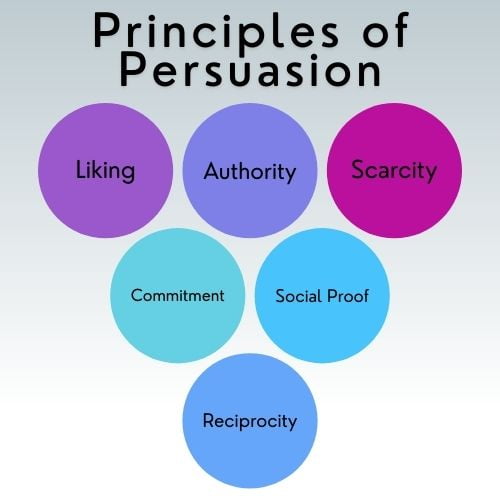Persuasion skills are incredibly valuable but can be difficult to master. Fortunately, with enough practice and the right approach, even the most inexperienced professional can become a persuasive powerhouse.
Jump To Section
What Is Persuasion?
Persuasion is the act or process of influencing someone’s beliefs, decisions, or actions through reasoning or request. It is a powerful force in daily life and has a major influence on society as a whole.
It can be used for both positive and negative outcomes, such as an ad trying to get you to buy something you don’t need or peer pressure that causes you to make a poor decision. Also, it’s used to influence people’s attitudes and behaviors and can be used to convert someone to a particular system of beliefs or to convince them of a certain opinion.
Why Are Persuasion Skills Important?
Persuasion skills are important because they can help individuals in a variety of ways, such as boosting performance, influencing other people, gaining trust, and motivating team members. Communication is one of the most important persuasion skills, as it is the quickest way to influence someone to think or act in a certain way. Additionally, persuasion skills can be used to encourage and motivate team members, which can lead to the overall success of the company.
Attributes of a Persuasive Person
Persuasive people typically have several traits that help them successfully convince others to agree with their ideas or take certain actions. These traits include:
- Confidence: A persuasive person is usually confident in their ideas and can communicate them effectively. They remain calm and composed when faced with opposition.
- How to Build It: Practice public speaking or engaging in discussions on topics you are passionate about to boost your confidence.
- Charisma: A persuasive person is often charismatic and able to draw people in with their charm. They use humor and other tactics to make their points more effectively.
- How to Build It: Work on your social skills, engage with diverse groups of people, and practice being more expressive and approachable.
- Knowledgeable: A persuasive person is usually well-informed and knowledgeable about the topic they are discussing. This allows them to provide facts and evidence to back up their arguments.
- How to Build It: Keep learning about your field. Read articles, take courses, and stay updated on new information and trends.
- Passionate: A persuasive person is often passionate about their ideas and can convey this enthusiasm to others. This helps to make their arguments more convincing.
- How to Build It: Identify topics you genuinely care about and dive deep into them. Share your enthusiasm with others to naturally persuade them.
- Listening: A persuasive person is usually a good listener and understands the needs and concerns of the people they are trying to persuade. This allows them to tailor their arguments to the specific audience.
- How to Build It: Practice active listening. Pay attention, ask questions, and show empathy to truly understand the other person’s perspective.
- Persistence: A persuasive person is often persistent and keeps trying even when faced with opposition. They are also able to adjust their approach if needed.
- How to Build It: Don’t give up at the first sign of resistance. Stay committed to your goals and be flexible in your approach to overcoming obstacles.
The Principles of Persuasion: A Simple Guide

Persuasion is all about convincing others to see things your way. Experts often reference six key principles of persuasion that tap into basic human psychology. Let’s break these down in simple terms.
1. Reciprocity
People tend to return favors. If you give someone something small, they feel more inclined to give you something in return. For instance, if you help a colleague with their project, they’re likely to help you in the future. Think of it as a friendly game of give-and-take.
How to Build It: Start by offering your help or small gestures of kindness. Over time, people will naturally feel inclined to reciprocate.
2. Commitment and Consistency
Humans like to be consistent with what they’ve said or done before. Once someone commits to something small, they are more likely to stick to it and agree to larger requests. For example, if you ask someone to sign a petition, they’re more likely to donate to the cause later.
How to Build It: Encourage small initial commitments. Once people take a small step, they’re likely to keep going.
3. Social Proof
People look at others to decide what to do. If a lot of people believe something is good, others will too. This is why testimonials and reviews are so powerful. When we see others raving about a product or service, we’re more likely to give it a try ourselves.
How to Build It: Showcase testimonials and positive feedback. When others see that people like them are satisfied, they’ll be more likely to follow suit.
4. Authority
We tend to trust and follow credible experts. If someone appears knowledgeable and trustworthy, their opinions and suggestions carry more weight. Think of the influence a doctor has when recommending a treatment—people are more likely to follow the advice because of the doctor’s expertise.
How to Build It: Build your credibility by gaining expertise in your field. Share your knowledge through content, presentations, or consultations to establish yourself as an authority.
5. Liking
People say “yes” to those they like. We are more easily persuaded by individuals we find personable and friendly. Building good relationships and finding common ground can make a big difference in convincing others.
How to Build It: Practice active listening, find common interests, and be genuinely friendly. Building rapport goes a long way in making your persuasion efforts more effective.
6. Scarcity
Things that are less available seem more valuable. When people think something is in short supply, they often want it more. Limited-time offers or exclusive deals trigger this principle of scarcity. It’s like the rush to get the last ticket to a sold-out concert.
How to Build It: Highlight the uniqueness or limited availability of what you’re offering. People are motivated to act quickly when they feel they might miss out.
Bringing It All Together
Understanding these principles can make you a more effective communicator. Whether you’re trying to persuade someone to buy a product, support a cause, or simply see things from your perspective, these key ideas can help you make a stronger, more compelling case. Remember, persuasion doesn’t mean manipulating; it’s about communication and connection.
So next time you’re in a situation where you need to convince someone, think about how you can use these principles. It might just make all the difference!
How to Improve Your Skills of Persuasion

Emotional Intelligence
Emotional intelligence is the ability to identify and regulate one’s own emotions, recognize the emotions of others, and use these abilities to communicate effectively and build healthy relationships with others. It is a key factor in how people interact with each other and is an important part of persuasion. People with high emotional intelligence are able to use their understanding of emotions to influence and persuade others.
One way people with high emotional intelligence use to become more persuasive is the 4-second rule. This rule states that when making a point, one should pause for four seconds before continuing. This pause allows the speaker to gain the attention of the listener and allows the listener to take in the point being made. It also allows the speaker to gauge the reaction of the listener and adjust their message accordingly. This technique can be used to increase charisma, pace conversations, and be more persuasive.
Another way people with high emotional intelligence use to become more persuasive is by appealing to human emotion. Research has shown that appealing to emotion can help make a case and build authority as a leader. This can be done by using stories, metaphors, and other techniques to create an emotional connection with the listener. This can help to make the message more memorable and persuasive.
Finally, people with high emotional intelligence use self-reflection to become more persuasive. Self-reflection allows people to identify their own emotions and understand how they can use them to influence and persuade others. By understanding their own emotions, people can better understand the emotions of others and use this understanding to create a more persuasive message.
Be Aware of the Surroundings
People who are aware of their surroundings are able to better understand the needs and concerns of their audience, which can help them tailor their message for maximum impact. Additionally, being aware of one’s surroundings can provide valuable context for understanding a situation and crafting an effective response.
Find Some Commonalities
Finding common interests can help build rapport and trust between two people, which can make it easier to persuade them. By finding common interests, you can focus on shared problems or mutual goals, which can make the listener more open to your other ideas.
Additionally, building strong relationships can help increase influence and make it easier to persuade individuals. For example, offering regular praise, engaging in team-building activities, and looking for opportunities to help cultivate meaningful relationships can help build trust and make persuasion easier.
Build Credibility
Start by establishing your credibility. This can be done in a variety of ways, from highlighting your expertise and experience to sharing relevant case studies. You can also use references to research and data to back up your claims. When people trust your judgment and feel confident in your abilities, it will be easier for them to accept your argument.
Always Come Prepared
When it comes to persuasive communication, the importance of coming prepared can’t be understated. To effectively convince your audience, you must have a thorough understanding of the topic, research to back up your claims, and a strong understanding of the motivations and interests of the people you’re trying to reach.
Start by researching your topic. Make sure you understand the key points and the evidence that supports them. This will help you craft strong arguments and ensure that you’re providing accurate information to your audience.
Then, familiarize yourself with the interests of your audience. Understand their motivations and needs, and ensure that your arguments are tailored to them. This can help make your message more relevant and engaging.
Finally, consider using visuals to illustrate your points. Visuals can help drive home your message and make it easier for your audience to understand your argument.
By taking the time to come prepared for persuasive communication, you’ll be in a better position to craft strong, effective arguments and successfully convince your audience.
Find the Why
When it comes to persuading someone, it is important to understand the other person’s “why” in order to be successful. There are several ways to find out the other person’s why, such as getting to know where they want to go and how badly they want to get there, and understanding where the other person is coming from. Really the best way is just to ask them why.
Understand Body Language
Body language is a powerful tool when it comes to persuasion. It can be used to convey a message without words and can be used to influence people’s opinions and decisions. Studies have shown that body language can be used to increase the effectiveness of persuasive messages and to make them more convincing.
For example, a study by researchers at the University of California, Berkeley found that people who used expansive body languages, such as open arms and legs, were more likely to be perceived as more persuasive than those who used more closed body language, such as crossed arms and legs.
In addition, research has also found that people who use more eye contact and facial expressions are more likely to be seen as more persuasive. This is because eye contact and facial expressions can help to create a connection between the speaker and the audience, which can help to make the message more convincing.
Finally, research has also shown that people who use more gestures and hand movements when speaking are more likely to be seen as more persuasive. This is because gestures and hand movements can help to emphasize certain points and make the message more memorable.
Use the Right Tone of Voice
The tone of voice used when trying to persuade someone can have a significant impact on the effectiveness of the message. Research has shown that people who use a more confident and authoritative tone of voice are more likely to be seen as more persuasive. This is because a confident tone of voice can help to emphasize the importance of the message and make it more memorable.
In addition, people who use a warmer, friendlier tone of voice are more likely to be seen as more persuasive. This is because a warm tone of voice conveys a sense of trust and can help build a connection between the speaker and the audience.
Finally, people who use a slower and more measured tone of voice are more likely to be seen as more persuasive. This is because a slower tone of voice can help the speaker emphasize important points and make their message more convincing.
Don’t Be Too Pushy
When it comes to persuasion, it’s important to remember that being too pushy can do more harm than good. People who use more subtle and effective persuasive techniques are more likely to be successful.
Active Listening
Active listening is a communication technique that involves actively engaging with the speaker to understand the meaning and intent behind the words they are saying. It requires being an active participant in the conversation and involves techniques such as being present in the conversation, restating and paraphrasing the speaker’s message in their own language, and using body language to show understanding and empathy.
Active listening can be a powerful tool for persuasion, as it helps to create alignment between the listener and speaker, and can help to build trust and understanding.
When it comes to persuasion, it’s important to remember that effective communication is the key to success. By taking the time to craft persuasive messages that use the right tone, body language, and facial expressions, you can ensure that your message will be heard and understood.
Did you enjoy this article on persuasion skills? Please share and subscribe below.








